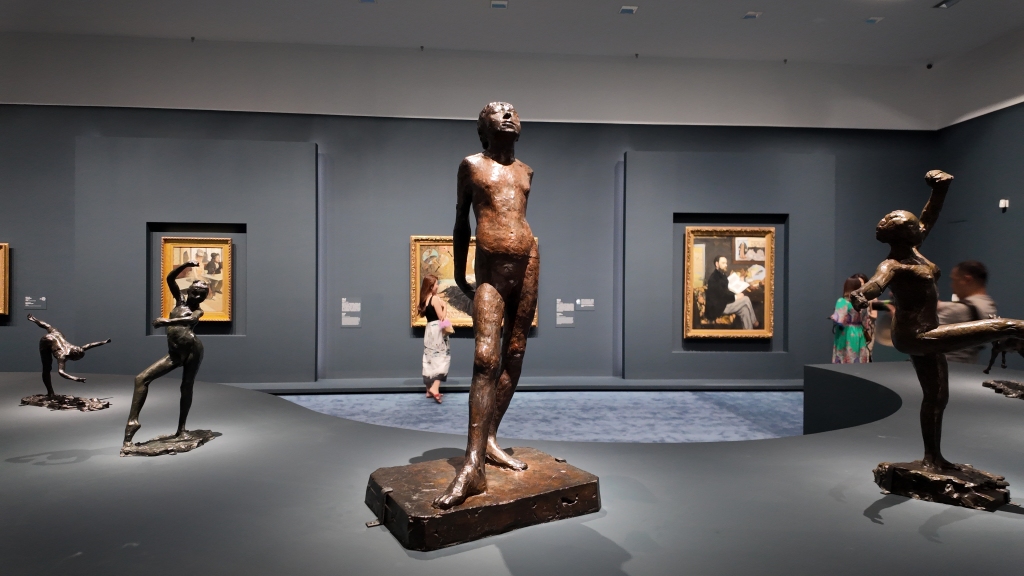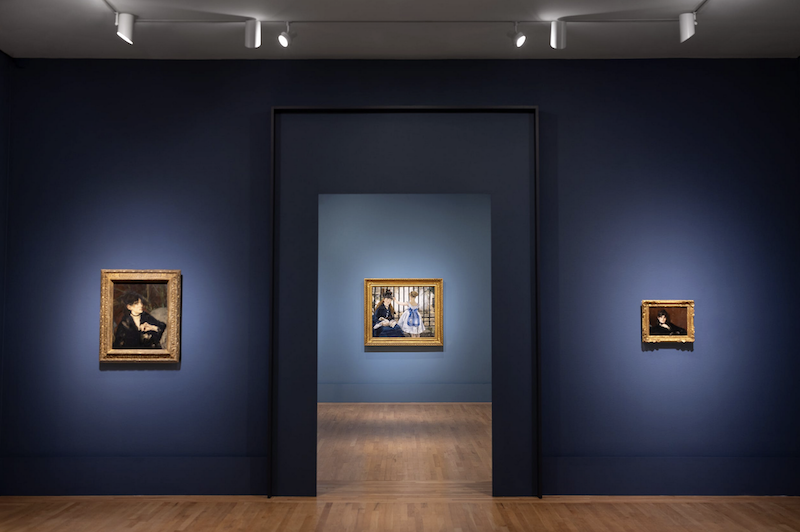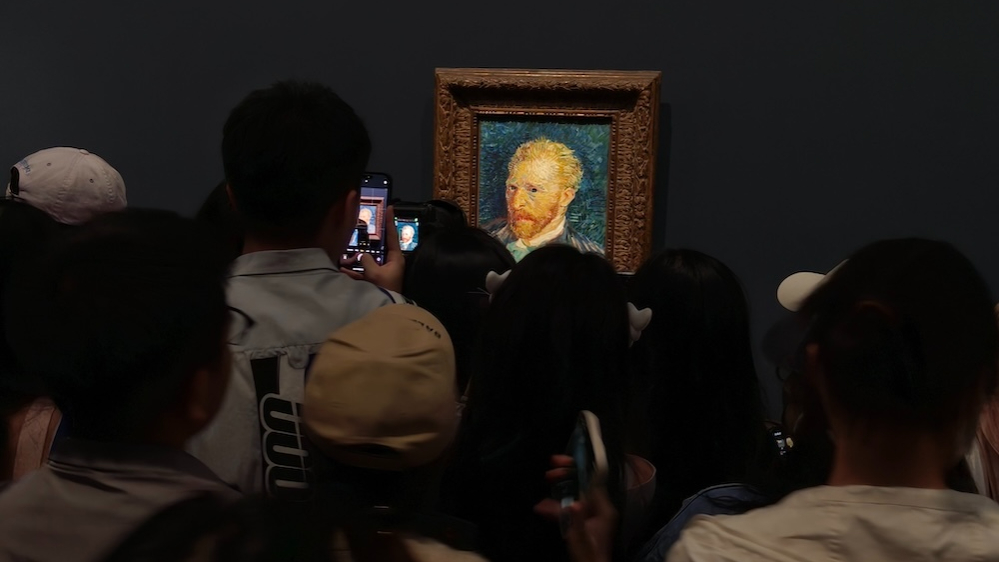
"The Musée d'Orsay in Paris focuses on artworks from 1848 to 1914, an era of dramatic change. The contemporary world we live in today was born during this period." This is how Sylvain Amic, president of the Musée d'Orsay, described the era covered by the Musée d'Orsay's collection in an exclusive interview with The Paper | Art Review. This period "constitutes a profound transition from tradition to modernity." The aesthetic changes brought about by this era can be seen especially in the Impressionist painter and sculptor Edgar Degas.
At the "Creating Modernity: Art Treasures from the Musee d'Orsay in Paris" exhibition currently being held at the Pudong Art Museum, several small sculptures were placed on an S-shaped stand - frozen dynamic horses and ballet dancers, echoing the works on the wall. They are all related to Degas, the French influential painter who was keen on painting ballet themes.

Degas sculptures at the Pudong Art Museum exhibition

The exhibition site, photo by The Paper reporter Liang Jia
A slightly twisted rich second-generation painter
If you were to draw a life sketch for Degas, it would probably be a bit complicated because he was a somewhat "twisted" person.

Edgar Degas (1834-1917) Self-portrait
This rich second-generation painter has a very classical aesthetic, but his expression method is very impressionist; he doesn't like the label of "Impressionism", but he participated in seven exhibitions to increase his popularity; he disdains to take a drawing board to sketch outdoors like those rough men of the Impressionists, but he likes photography and depicting instantaneous dynamics. He doesn't get along well with the Impressionists, but he collects paintings by Gauguin and Van Gogh.

Horse Racing in Front of the Grandstand (1866-1868)

Detail. In this painting, he is standing in the middle of the racetrack, ready to charge out with his horse. He liked to depict the preparations before the race.
Edgar Degas (1834-1917) is one of the important representatives of French Impressionism, but he prefers to call himself a "realist" painter. His works are famous for their accurate capture of dynamic moments, unique composition perspective and profound depiction of modern life, especially in the creation of ballet themes, which has achieved extremely high artistic achievements.
Let's first look at some of the sculptures in the exhibition. Compared to the Rodin sculptures in the exhibition, you may wonder why they are all horses and ballet dancers?

Degas was born into a wealthy banker family in Paris. He initially studied law but soon turned to art. He studied at the École des Beaux-Arts in Paris and was influenced by the neoclassical master Ingres, who emphasized the importance of lines and sketches. Since his youth, his math books were filled with drawings of riding queues and animal forms. Horse racing was very popular in France as early as 1850, and Degas liked to paint horse racing because he could use his brush to record popular activities at the time. In the late 1860s, he turned his attention to the newly built racecourse events.

The Dancing Studio at the Opera House, Rue Pelletier (1872)

Detail of the work. Male audience members or "patrons" often appear in ballet works.
In addition to going to the racetrack, he traveled around to study and copy classical works. He had an independent studio in the city center. He loved ballet and could sketch backstage and in the practice room. In his early days, he liked historical themes and portraits. From his works, one can feel the vision that a wealthy life brought him.
Great art often emerges from great upheavals. When the Franco-Prussian War broke out in July 1870, Manet, Degas, and Morisot remained in Paris, participating in military and political affairs; Renoir served in a military regiment outside the city; Monet and Pissarro went to England, where they were not welcomed by the art establishment; and Bazille was killed on the front.
The Franco-Prussian War marked a turning point in Degas' artistic career, and these experiences also inspired the Impressionist painters to seek a new way of looking at the world.
Before the war, Degas's works were more classical, but after the war, his family went bankrupt due to his brother's debts, forcing him to sell paintings for a living. This turbulent period allowed him to witness social upheavals, violent conflicts and urban ruins, which to some extent deepened his critical observation of modern life. He gradually abandoned historical paintings and grand narratives and turned to focusing on moments in daily life, such as dancers, laundry women and horse racing scenes, and developed more dynamic compositions.
Ballet dancers and the “aesthetics of the moment”
After the 1870s, Degas began to focus on modern life in Paris, such as theaters, laundresses and ballet dancers. He rarely painted outdoors, but instead created works in the studio based on memory and sketches. After 1880, Degas' eyesight deteriorated severely and he turned to sculpture.

The Masseuse, The Bathtub, Woman Sitting in an Armchair Wiping the Left Side of Her Body (1921-1931)
Degas's sculptures broke through the static constraints of traditional sculptures and reconstructed the language of modern sculptures through dynamic capture and material experiments. One of them, "Nude Study of a 14-year-old Little Dancer", is eye-catching. This should be his draft, and the final statue is about 1 meter high.

Exhibition view, “Nude Study of a 14-year-old Dancer”
Degas created more than 150 sculptures in his lifetime (mostly wax, not bronze works). During his lifetime, he only exhibited "The Little Dancer Aged 14" (exhibited at the Sixth Impressionist Exhibition in 1881), and the rest were private experiments. After his death, his heirs cast more than 70 wax sculptures into bronze. Initially, he designed more than 10 different shapes for the "little dancer", and finally chose the "T" standing posture of classical ballet. Different from the traditional ballet elegance, the little dancer's thin torso and reversed arms seem to resist an invisible bondage. In fact, the original work was made of wax, and was denounced as "looking like a medical specimen" because it used real cloth and hair.

The bronze-cast Little Dancer Aged 14 is now in the hands of many museums and collectors. This is a collection of the Metropolitan Museum of Art. (Not on display this time)
In the 19th century, French ballet art had fallen to a low point, almost becoming a performance to satisfy the public's senses. Most young ballet dancers came from the lower classes. Before Degas, no one paid attention to this group. He once said frankly: "My sculptures will never reach the perfection of sculpture art." Its essence is "an exercise to make painting more vivid." These works are made of fragile materials such as beeswax and clay, with fingerprints and knife marks on the surface, emphasizing the sense of "unfinished" process, challenging the eternity of classical sculptures and the aesthetic standards of traditional sculptures.
Degas has always been good at depicting moving subjects. Influenced by Muybridge, the pioneer of dynamic photography, Degas decomposed movement into continuous moments. He refused to copy the static solidification of photography, but instead refined the mechanical balance and temporality in movement, such as the suspended moment of a running horse or the subtle shift of a dancer's center of gravity.

Horse Galloping on Right Foot (c. 1887)
This work accurately captures the critical state of the horse's "flying period" - the right hind hoof lightly touches the ground, the front hoof curls up, the neck stretches forward, and the spine is streamlined and arched. The prototype surface is covered with dotted textures, simulating the light and shadow trembling of impressionist brushstrokes. The horse's muscle lines are shaped with rough scraping marks, transforming the "sketching" of painting into three-dimensional language.
The pose of the galloping horse can be found in similar compositions in Degas' horse racing paintings from the 1870s.

"Female dancer, fourth position, feet raised forward, left leg supported (secondary study)"

Spanish Dancer

Dancer, Arabesque "Spreading Wings in the Wind"

Female dancer, large arabesque, "Spreading wings in the wind", third breakdown
In 19th century ballet, Arabesque was given a dual interpretation of sublimity and eroticism. When the dancers raised their hind legs, their bodies were looming under their short skirts. Lautrec once said, "eroticism flashes in the well-trained limbs." Degas used a cold anatomical perspective to strip away desires and focus on the scientific nature of muscle power, responding to the controversy about dance at the time.

"Female Dancer Looking at the Sole of Her Right Foot" The difference is that the one on the left has a rough texture.
He often sneaked into the backstage of the Paris Opera House to observe dancers' training and resting scenes, rather than the perfect performances on the stage. This "behind-the-scenes perspective" makes his works have both dynamic tension and human authenticity. Two works show the moment when dancers adjust their shoes while sitting: leaning forward, one leg bent to check the sole of the foot, and the other leg relaxed and stretched. Degas deliberately weakened the facial details, highlighting the curves of the shoulders and back and the dynamics of the hands, sublimating the daily behavior of "tying shoelaces" into a focused ritual.
Compared with the dancers in the Moulin Rouge painted by Lautrec, there is no hustle and bustle of performance, and the "eternity of movement" is condensed in static state. "Incompleteness" is the core of its modernity, and it has become a paradoxical monument of dynamic eternity in the erosion of time.

